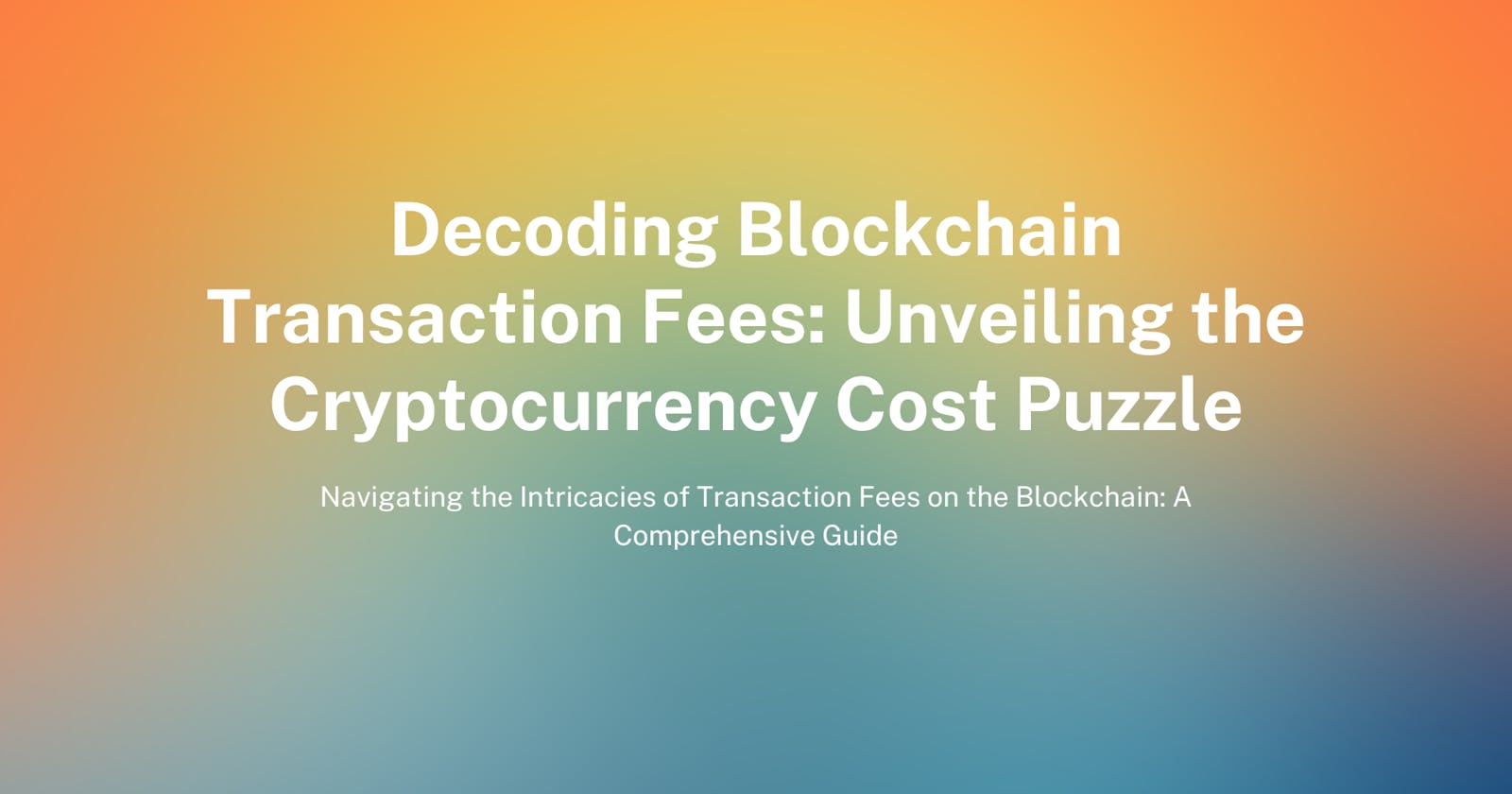Decoding Blockchain Transaction Fees: Unveiling the Cryptocurrency Cost Puzzle
Navigating the Intricacies of Transaction Fees on the Blockchain: A Comprehensive Guide
Hey there,
I'm thrilled to have you here on my blog. In this article, we'll embark on a fascinating journey through the intricacies of blockchain transaction fees. Have you ever wondered how the gas fee you pay when making transactions on the blockchain is calculated? Fear not, as we will dive into the process together and demystify this cryptocurrency cost puzzle.
Now, I must confess, I'm relatively new to the web3 space. So, while this article might not be 100% accurate, I want to assure you that I've dedicated considerable time to research before bringing this information to you. With that said, let's delve into the captivating world of blockchain transaction fees and unlock their secrets.
How the blockchain works
To have a better understanding of this article, we need to know how the blockchain operates. At its core, the blockchain is powered by nodes, which are individuals or entities that participate in maintaining the network. These nodes play a vital role in validating and verifying transactions. But did you know that these hardworking nodes also receive compensation for their efforts? When you make a transaction on the blockchain, a dedicated "miner" or "validator" earns a small portion of the cryptocurrency involved in that transaction. These incentives ensure that people are motivated to continue running nodes and contributing to the network's security and integrity.
Demystifying Gas: Understanding its Role in Blockchain Transactions
Now, let's unravel the concept of gas and its significance in blockchain transactions. Gas is essentially a unit of computational measurement within the blockchain ecosystem. When you perform a transaction, the amount of computation required determines the quantity of gas consumed, and subsequently, the gas fee you need to pay. In simple terms, the more complex and resource-intensive your transaction is, the higher the gas fee associated with it.
Gas Fee: From Simple Transactions to Complex Operations
When it comes to gas costs on the blockchain, simplicity or complexity can make a significant difference. For straightforward tasks like sending Ether, the unit of gas typically carries a relatively low price tag. However, as the operations become more intricate, such as minting an NFT or depositing funds into a DeFi contract, the gas costs tend to increase due to their higher computational requirements.
In simpler terms, the computational intensity of an operation directly impacts the associated gas costs. Basic transactions may require minimal computation and thus incur lower gas fees. On the other hand, complex operations like NFT minting or DeFi interactions involve more intricate computations, resulting in higher gas fees to compensate for the additional resources consumed.
By understanding the correlation between the complexity of an operation and its corresponding gas costs, we can make informed decisions and anticipate the expenses associated with different blockchain activities.
Dynamic Gas Fees: Congestion and Transaction Volume Impact
In addition to computational complexity, another crucial factor that determines the gas fee on the blockchain is the level of congestion within the network. When the network experiences high activity and a surge in transaction volume, fees tend to increase due to the competition for limited block space. This is because miners prioritize transactions with higher gas fees, aiming to maximize their earnings.
During periods of congestion, when numerous transactions are competing for inclusion in the next block, users may need to pay higher gas fees to ensure their transactions are prioritized and processed promptly. On the other hand, during quieter periods with fewer transactions, fees tend to be relatively lower as there is less competition for block space.
Understanding the dynamics of network congestion and its impact on gas fees is essential for users to plan their transactions effectively. By considering the prevailing congestion levels, users can adjust their gas fees accordingly to strike the right balance between transaction priority and cost.
The Calculation Process: Gas Used and Gas Price
Now, let's explore how gas fees are actually calculated on the blockchain. The calculation involves two main components: the amount of gas used and the gas price. Allow me to break it down for you.
When you initiate a transaction, the blockchain measures the amount of gas consumed during its execution. For instance, transferring 1 Ethereum might require a gas usage of 21,000 units. This value represents the computational resources needed to process the transaction.
The gas price, on the other hand, refers to the cost per unit of gas. It is usually denoted in small fractions of cryptocurrency, such as Ethereum. For example, at the time of your transaction, the gas price might be 0.000000002500000023 Ethereum.
To calculate the transaction fee, you multiply the gas used by the gas price. In the example above, multiplying 21,000 (gas used) by 0.000000002500000023 (gas price) yields 0.000052500000483 Ethereum. This amount corresponds to the fee you would see in the "Transaction Fee" section when viewing the transaction details on etherscan.io.
If you want to verify these calculations, you can navigate to etherscan.io and find the transaction you're interested in. Scroll down to the bottom of the transaction page, where you'll find two sections: "Gas Limit & Usage by Txn" and "Gas Price." By multiplying the values in these sections, you'll see that they align with the amount specified in the "Transaction Fee" section.
Conclusion:
Throughout this comprehensive guide, we've demystified the intricacies of blockchain transaction fees, shedding light on their calculation methods and the factors that influence their fluctuation.
We learned that transaction fees are determined by various factors, including the level of congestion within the network, and the computational complexity of the operation.
By grasping these concepts and monitoring network conditions, we can make informed decisions about our transactions and also optimize the fees by balancing complexity and cost.
Thank you for reading. If you made it to this part of the article, I'd be glad to connect with you on Thread and Twitter.
